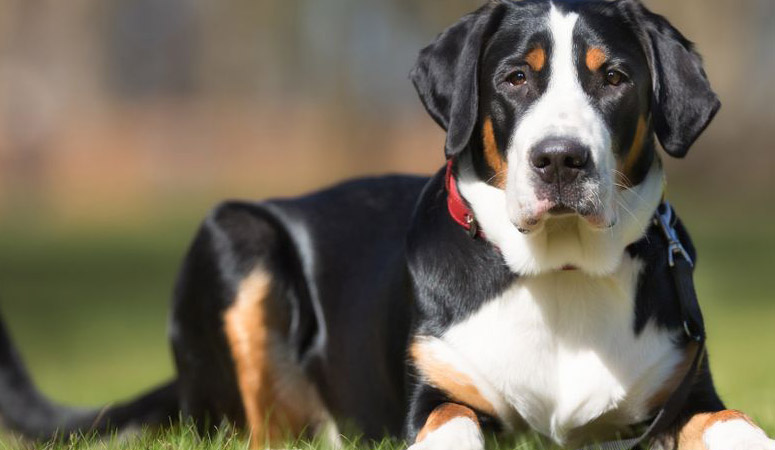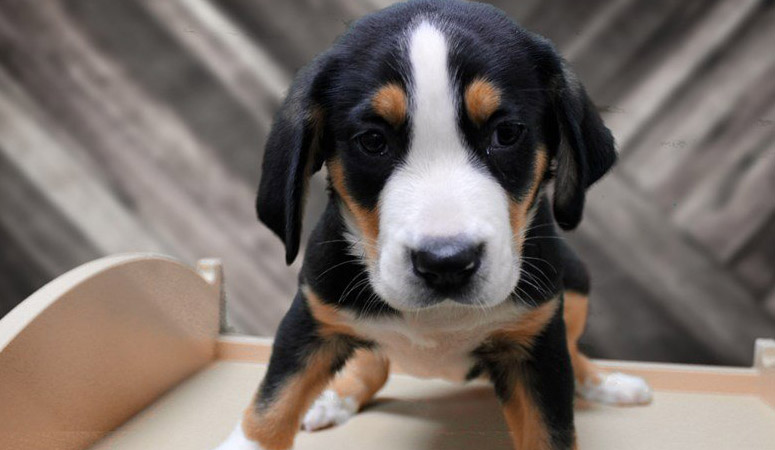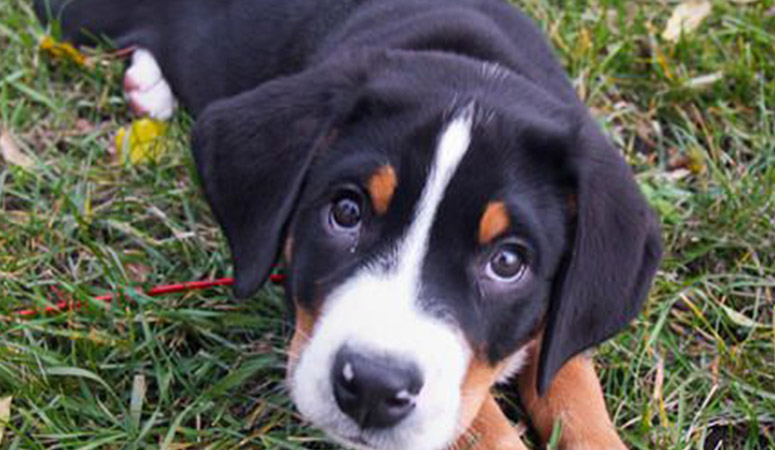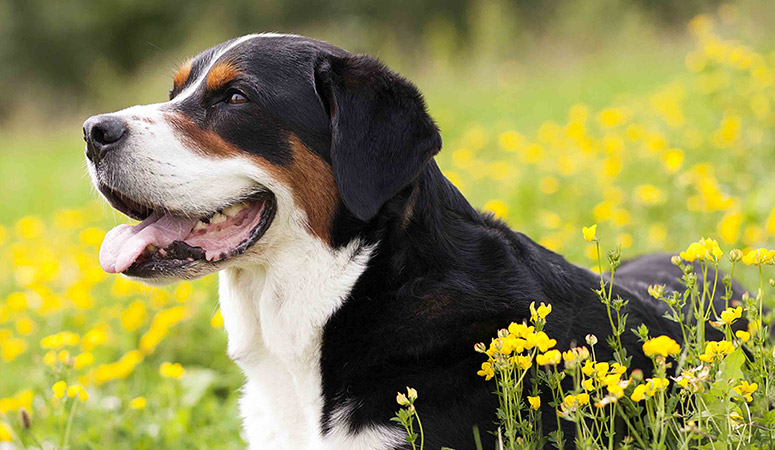Greater Swiss Mountain Dog
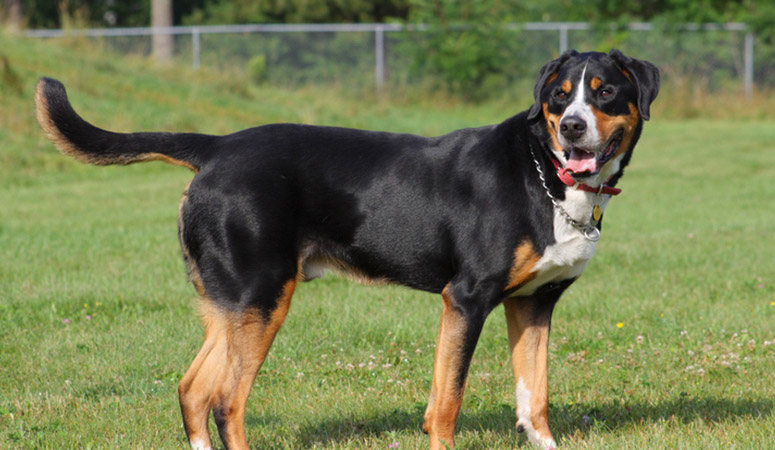
Giant, and strong, the Greater Swiss Mountain Dog is a working dog famous for a dense coat of striking black, red, and white markings. This dog breed is believed a descendent of Roman Molossian dogs, and they were used mainly for herding and guarding since the Middle Ages. Today, Swissies enjoy living a family pet life, but they like to be busy because of their working heritage.
| Other Names | Gran Boyero Suizo, Grand Bouvier Suisse, Great Swiss Mountain Dog, Grosser Schweizer Sennenhund |
| Color | Black, White & Red, Blue White & Tan, Red & White |
| Height | Males: 25-29 inches. Females: 23-27 inches. |
| Weight | Males: 132-155 pounds. Females: 110-133 pounds. |
| Life Span | 8-11 years |
| Personality | Faithful, Family-Oriented, Dependable |
| Exercise | Energetic |
| Origin |
| Popularity | #73 |
| Groom Needs | Weekly |
| Kids Friendly | Yes |
| Dog Friendly | Yes with supervision |
| Watch Dog | |
| Family Dog | |
| Litter Size | 5-10 |
Greater Swiss Mountain Dog Pictures
Greater Swiss Mountain Dog Video
Introduction
The Greater Swiss Mountain dog has plenty of fans, and these fans love to call this much-loved dog “Swissy.” He is a powerful breed and excels in many kinds of dog sports. He is also playful and affectionate. If you are new to having a pet dog, you might find this well suited to the family. This dog will fit into an active family who intends to spend heaps of time with this pet. They’re good with kids too, but just remember, he is a big dog; so can accidentally knock over a small child. Because of his working heritage, he enjoys being a busy dog. He stands about 28 inches at the shoulders and weighs around 140 pounds – he’s a big handsome dog as you can see. They have a deep loud bark which makes them a good watchdog – he also needs plenty of space to stretch his legs. It’s important to start early with obedience training and socialization classes for this dog. You will notice with the Swissy, if you buy a pup, they are slow to mature physically and mentally, staying like a puppy until they are around 3 years old! Their coat color is distinct, with a black outer coat and rust and white markings on the face and body. Grooming this dog is not hard at all as his coat his short. Just a brush once or twice a week will keep this dog in tip-top condition, naturally with nutritional food and plenty of healthy exercises.
Living with Greater Swiss Mountain Dog
It is not very complicated to groom Greater Swiss Mountain Dogs, this breed is naturally clean and their short coat is easy to care for. Brushing once or twice a week with a rubber curry brush or hound glove to remove dead hair and distribute skin oils to keep the coat gleaming. But they are double coated and do blow their undercoat, usually twice a year, during this period, they benefit from a good bath and blow-out, followed by a thorough brushing with a rake or shedding tool.
Clean your dog’s ears with a gentle, dog-friendly cleanser to prevent dirt buildup that may cause infections. And brush the teeth several times a week to keep fresh breathe and prevent gum disease. Besides, trim the nails every month to prevent cracking.
The Greater Swiss Mountain Dog requires moderate exercise, which could be in the form of a few long walks or play sessions to stay in prime condition. And when taking the dog to walk outside, the owner should be in front of your dog to keep a leadership. And the Swissy is not suited to apartment or condo life. They need room to roam and a house with a large, securely fenced yard because this is a large, working dog breed. They are much better suited for the people who need a hiking companion than the person wanting a bicycling or marathon-running partner.
The Greater Swiss Mountain Dog can thrive on many types of diet, from kibble to raw to a combination of both. Generally, it is recommended to feed a Greater Swiss Mountain Dog with four to five cups of high-quality dry dog food, divided into two meals. More importantly, the food amount should depend on the dog’s weight, size, age, and activity level. There should be fresh and clean water at all times.
Some dogs are easy to get overweight, so you need to watch their calorie consumption and weight level all the time. Treats may be an important aid in training, but excessive intake can lead to obesity. Also, owners need to distinguish which human food is safe for dogs and which are not. If you have any problems with your dog’s weight or diet, just consult from your veterinarian.
The Greater Swiss Mountain Dogs are prone to the following health conditions: canine hip and shoulder dysplasia, shoulder osteochondritis dissecans, gastric torsion, splenic torsion, seizures, cataracts, epilepsy, and entropion, etc.
Major concerns: CHD
Minor concerns: shoulder OCD, panosteitis, splenic torsion,distichiasis, gastric torsion, female urinary incontinence, seizures
Suggested tests:
Elbow Evaluation
Shoulder Evaluation
Hip Evaluation
Ophthalmologist Evaluation
Total Annual Cost: $3538
Cost is estimated for the first year and may vary depending on many factors, such as dog food, health care, leash, collar, licensing, possible fencing, crates, training and obedience classes, dog-walking, grooming, treats, toys, flea, tick, and heart-worm meds, microchips, etc.
Greater Swiss Mountain Dogs are smart but headstrong which makes them a bit difficult to train, so it requires persistent training. And it is useful to use dog treats to motivate this breed when training. It is not suggested to use any harness-type training device on this breed. The use of a harness would make them pull that much harder as they are a draft breed. It is recommended to start early socialization and puppy training classes like other dog breeds.
Besides, Greater Swiss Mountain Dogs are capable of advanced training. They are strong and steady athletes who excel at agility, drafting (pulling carts), hiking with packs, and herding.
History
This magnificent, mighty dog originates from Switzerland. He was developed to be an all-around working dog; to herd cattle, and pull carts, but also to stand guard. He is considered one of Switzerland’s oldest dog breeds, but as with many of the dog breeds, there are a few theories as to the Swissy’s origins. A long-standing one though is that they descended from the Mastiffs who were brought to the Alps by invading Roman Legions.
There was a time when this dog was thought to be the most popular dog in Switzerland but by the 1900s their numbers had started dwindling.
In 1908 a man called Albert Heim noticed two dogs at a Swiss Kennel Club jubilee, which were listed as “short-haired Bernese Mountain Dogs” at that time. Heim tried hard to get the dogs recognized as a separate breed and in 1909; the Swiss Kennel Club listed the Greater Swiss Mountain Dog (Grosser Schweizer Sennenhund) in the Swiss Stud Book.
In 1968 the first Greater Swiss Mountain Dogs were brought to the US, and the Greater Swiss Mountain Dog Club of America was formed. The Swissy was recognized by the American Kennel Club in 1995, as a member of the Working Group, ranking around 97th at the AKC.
Helpful Information
Breed Club: GREAT SWISS MOUNTAIN DOG CLUB OF AMERICA, INC.
Breed Club Link: http://www.gsmdca.org/
Breed Club Rescue: Greater Swiss Mountain Dog Rescue Foundation
Breed Club Rescue Link: http://www.gsmdrescue.org/

